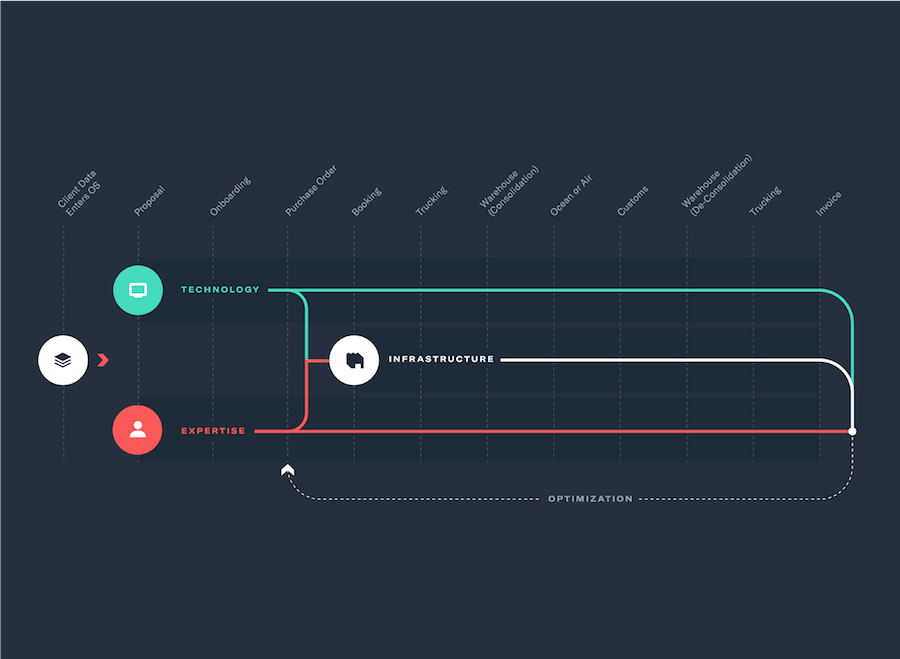
March 18, 2019
When is an Operating System More Than an Operating System?
Tags:
When is an Operating System More Than an Operating System?

March 18, 2019
I don’t know about you, but it seems to me like today’s world runs on operating systems. Behind the scenes, they seamlessly connect, enable and orchestrate the software and devices we rely on to work, learn, share, play, and create. And, combined with the connected power of the Web, they make our everyday lives better, enabling us to get much more out of our digital experiences.
If you’re like me and have been working in tech for a while, you might ask: does the world really need another operating system? Well…maybe. What if there were an operating system that was about more than just technology? What if it also managed all of the essential, real-world resources required to modernize a centuries-old, $2 trillion industry sorely in need of transformation?
The industry in question is freight forwarding.
If you’re surprised that freight forwarding is such a large industry, you shouldn't be: it’s the “circulatory system” for global trade — without freight forwarding, international commerce simply wouldn’t exist. And global trade is what lifts individuals (and even countries) out of economic despair into the heights of prosperity. In fact, the lack of trade is largely responsible for holding back many parts of the developing world.
Freight forwarding is a highly complex industry. Moving a single pallet of goods is a relay race that involves handoffs between myriad separate and largely disconnected logistics vendors. Today, this process is handled largely by email, phone, paper, and fax.
In fact, of the top freight forwarders in the world (based on volume), none were launched after 1994, the year the commercial Internet was born (Netscape). These companies are not Internet-native and they’re starting to scramble now to adapt their legacy technology systems to the modern age. So far, to our minds at Flexport, their efforts have been largely unsuccessful.
The result is an extremely poor and antiquated customer experience for businesses moving goods across the globe. With these legacy vendors, customers have had very limited visibility and insight into the status of their critical and time-sensitive shipments as they travel from origin to destination. Additionally, freight transit times are unpredictable, and costs can easily get out of control. All of this causes frustration and sometimes even fiscal damage to their businesses.
The Operating System for Global Trade. More than an OS — a new way to do business.
Today, on the heels of securing $1B in funding led by the SoftBank Vision Fund, Flexport is proud to announce The Operating System for Global Trade — a strategic operating model for global freight forwarding that combines technology and analytics, logistics infrastructure, and hands-on supply chain expertise (TIE), all delivered via a highly-available and secure cloud software platform. This unique offering unifies and simplifies the freight forwarding experience for our customers and their partners, giving them deep, real-time visibility and insight into what was previously a “black box” experience.
Importantly, the Operating System for Global Trade also unifies a customer’s supply chain ecosystem, allowing customers to bring their manufacturers and suppliers onto the platform, simplifying and dramatically improving the performance of their global supply chains.

The Operating System for Global Trade consists of three core components:
Technology: All the parties in global trade — importers, exporters, trucking companies, ocean carriers, airlines, customs agencies, port terminals and more — are connected via a secure, cloud software platform built on AWS. This provides complete, real-time visibility into the location and status of their shipments, at every step of the journey and across all modes of transit. Analytics help provide additional insight and value to customers. Additionally, by structuring all the data in global trade, Flexport opens the door for machine intelligence to optimize supply and demand, unlocking a new level of transformational power for a business.
Infrastructure: In addition to offering customer access to all modes of transport — ocean, air, truck, and rail — Flexport is building cross-docking warehouses near all major global population centers, each connected by high-frequency air, ocean, truck, and rail freight line-hauls in a global hub-spoke network. Businesses leverage this connected network to cut transit times for their goods and dramatically lower the working capital needs of partners and suppliers on the network. As companies invite their trading partners and logistics service providers onto Flexport’s software platform, and the network achieves scale, Flexport will share the benefits of that scale back to the participants, unlocking a virtuous cycle of efficiency and cost savings.
Expertise: 24/7/365, customers can interact — digitally or telephonically — with a core team of operations, customs and data experts to discuss any aspect of their shipments. Additionally, Flexport empowers businesses with value-added services including cargo insurance, trade finance, customs brokerage, vendor management, network optimization, and other supply chain advisory services.
At the core of the Operating System for Global Trade is data. In many ways, Flexport is a “data company masquerading as a freight forwarder” in that we use a powerful asset (data), to deliver a radically superior customer experience, greatly increased operational efficiency, and deep insight and visibility. The range of potential data-centric product and service offerings for customers and others in the global freight forwarding ecosystem is virtually limitless.
The value Flexport and the Operating System for Global Trade bring to customers and their partners is clear and highly strategic:
- Deep visibility and control, from origin to destination
- Faster and more reliable transit times
- Lower and more predictable supply chain costs
- A secure and compliant platform you can trust
It’s time for a change.
As we’re all aware, much of the world has gone from an old economy to a new economy, but the supply chain hasn’t kept up. Consumers used to be fine with a three-week delivery window, but now they’re in control and want two days or even two hours. You can’t manage a New Economy supply chain by email and pieces of paper, yet that’s still the standard in freight forwarding. I believe the industry needs a radically different approach. A new way to do business. An Operating System for Global Trade.
Learn more now on our new website at www.flexport.com
About the Author

March 18, 2019
About this author


